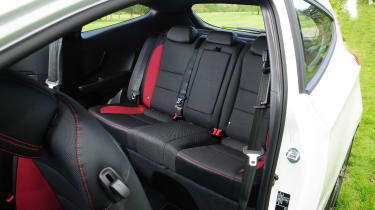Hyundai i30 hatchback (2011-2016) - Practicality & boot space
Cabin storage and passenger space in the Hyundai i30 are great, and it’s a front-runner in the class for boot space, too
The Hyundai i30 is a front-runner in the compact hatchback class for passenger and luggage space, with boot space that’s ahead of the Ford Focus and on a par with the VW Golf. Back-seat passengers have plenty of room, while there are deep door bins and good centre console storage up front.
Hyundai i30 interior space & storage
As soon as you slide into the driver’s seat of the i30, you can’t miss the thick windscreen pillars, which won’t exactly help visibility when you’re pulling out of junctions. The view through the narrow rear windscreen can make parking a bit difficult, too, though this is alleviated on the SE, SE Nav and Premium models, as they’re fitted with rear parking sensors. A reversing camera, however, is exclusive to the SE Nav and Premium trim levels.
The driver and front-seat passenger get huge door pockets, which can swallow large drinks bottles, while there are more cubbyholes in the centre console and under the central armrest, as well as a large cooled glovebox. There are also large pockets in the back of five-door cars. Passengers sitting in the rear have plenty of leg and headroom, too.
Unlike the VW Golf, there’s barely any transmission tunnel to speak of, so the middle-seat rear passenger has room for their feet. And wherever you’re sitting in the back, the wide-opening doors ensure it’s easy to get in and out.
Boot space
Lift the hatchback bootlid and you’ll find a large 378-litre boot space with the rear seats in place. That’s a massive 62 litres more than in the Ford Focus and 40 litres more than the Mazda3 has to offer. The i30 is pretty much on par with the Volkswagen Golf and SEAT Leon, which offer 380 litres, although as with most cars in this class, it trails the Skoda Octavia, which can hold up to 590 litres in its boot.
The seats can easily be folded flat in the Hyundai to free up 1,316 litres of space, which is more than in the Focus, Golf and Leon, but strangely less than in the Mazda, which has a 1,360-litre maximum capacity. Again, the Octavia has a big advantage overall here, with a vast 1,580-litre maximum boot size.
Still, the Hyundai scores with neat touches like a 12v socket in the boot on all but the S version. If you trade up to the i30 Tourer estate, its larger dimensions mean it has a 528-litre boot that can be expanded to 1,642 litres.
Towing
As is usually the case, cars with diesel power have the edge in terms of towing capacity. No matter which gearbox you go for, the 108 and 134bhp 1.6-litre diesel models can pull up to 1,500kg. The petrols don’t perform as well, but even the 99bhp 1.4-litre can tow 1,200kg. The 1.6-litre petrol marginally tops that by managing 1,300kg, but only when fitted with a manual gearbox – specify the automatic, and it’s no better than the 1.4-litre.














